Democratic presidential candidate Sen. Bernie Sanders (I-VT) speaks at the University of Houston on Feb.y 23, 2020. (Drew Angerer/Getty Images)
In California Primaries, Sanders Leads Polls and Orange County Hotly Contested: Analysts
All eyes will be on Bernie Sanders, Orange County, and two particular congressional districts as voters head to the polls March 3 to vote in California’s presidential primary elections, political analysts say.
Though they differ in their perspectives on many issues, California-based political analysts Dr. Tony Quinn and Dr. Sherry Bebitch Jeffe can agree on one thing: barring any major upsets, Sanders will likely win the Democratic primary in California.
Vermont Sen. Bernie Sanders is leading the Democratic field for presidential nominee nationally and in California, recent political polls show.
A Public Policy Institute of California (PPIC) survey released Feb. 20 shows Sanders with 32 percent of the vote among likely Democratic voters in the state, followed by Joe Biden with 14 percent, Elizabeth Warren with 13 percent, Michael Bloomberg with 12 percent, and Pete Buttigieg with 12 percent. Eight percent of voters are undecided, and no other candidate has more than five percent.
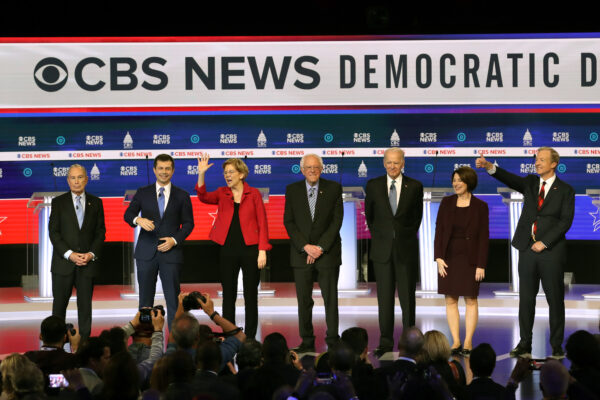
Several other recent political polls show Sanders leading the California Democratic race, but with about 24 percent of the vote—not 32. Nationally, recent general election polls show Sanders slightly ahead of President Donald Trump. Sanders was named the candidate most likely to defeat Trump by 34 percent of voters in the PPIC survey.
Sanders is also gaining traction among Latino and black voters in the state, said Jeffe, a retired Professor of the Practice of Public Policy Communication at the Sol Price School of Public Policy, University of Southern California.
“I think he’s taken a lot of that [support] from Biden, and that’s important. But, the younger voters have always basically been Bernie’s. It’s ideological. It’s change. His ideology is far more revolutionary, shall we say. And again, he’s got an operation here. He’s got a presence here that other candidates don’t,” she said.
“The Democratic Party itself has changed and the activists are more and more political,” Jeffe said. “He has an incredible organization. He could hit the ground running because he still had that organization from 2016. It was not surprising that he is ahead … Bernie has been here and his ‘movement’ has sustained over the last four years.”
While Quinn agreed Sanders has the best chance of winning in California, he said Sanders still has a long way to go nationally. He has to win enough delegates in more than a dozen other states to win the nomination. And, even then, he has to defeat Trump to become president.
“He got 46 percent against [Hillary] Clinton [in 2016]. He has a strong following and it’s not unlike Trump, who had a strong following when he first started out. So, it may very well be that Bernie is impossible to stop and it could very well be that he gets the lion’s share of delegates on Super Tuesday,” said Quinn, senior editor at California Target Book. “But having Bernie as a nominee is going to be really hard for the Democrats. He is very far left, you know.”
The top concern on the minds of most Democratic primary voters is choosing a candidate who can beat President Donald Trump in the Nov. 3 general election, Jeffe said. And, their second priority is making sure they defeat any Republican candidates who support Trump.
In the Feb. 25 Democratic debate, Sanders came under fire from other candidates for his self-declared socialist agenda.
Though Sanders proudly bills himself as a ‘democratic socialist,’ Jeffe said the term socialism no longer has the same negative connotation it did during the Cold War.
For younger voters, socialism is seen more as government involvement, “and they are OK with that,” Jeffe said. “If they are socialists, they are different from what socialists used to be … Socialism doesn’t mean what it meant for old geezers like me which is a synonym for communism. Socialism doesn’t mean that anymore.”
But, Quinn disagrees.
“It certainly does mean that,” he said. “That’s the problem: a lot of the liberals now are trying to pretend it means something else. There are three major socialist countries in our hemisphere: Cuba, Nicaragua, and Venezuela. Bernie Sanders says his brand of socialism is more like Denmark and Sweden. But Denmark and Sweden are not socialist countries.”
The Nordic countries do not have the same government controls characteristic of socialism—rather they have private market economies with high taxes to pay for government services.
He says socialism means the same thing it always has, and that the 2020 presidential race is all about socialism.
“Nobody knows what socialism means, but traditionally it has meant control of all aspects of government by a group of reliable bureaucrats,” Quinn said. “In the Soviet Union, they were called nomenklatura, and these are the bureaucrats who made all the decisions and the five-year plans. There was no private property, no private ownership of anything. That’s what socialism is, and to pretend that it’s something else is kind of denying what history tells us.”
On the other hand, even though California is a decidedly blue, one-party state, the rest of America has no intention of electing a socialist to the White House, Quinn said.
“There is no sign that the people of California want a socialist government, but there is a sign a lot of people here like Bernie Sanders because he picks on the establishment,” he said.
Hotbed on the Hustings
The most highly contested races this election season are mostly in Orange County, a typically red county that flipped to blue in 2018. Republicans lost six seats to Democratic contenders:
Congressional races:
• 39th District: Ed Royce (R) retired. Gil Cisneros (D) defeated Young Kim (R).
• 45th District: Mimi Walters (R) was defeated by Katie Porter.
• 48th District: Dana Rohrabacher (R) was defeated by Harley Rouda (D).
• 49th District: Darrell Issa (R) retired. Mike Levin (D) defeated Diane Harkey (R).
• 39th District: Ed Royce (R) retired. Gil Cisneros (D) defeated Young Kim (R).
• 45th District: Mimi Walters (R) was defeated by Katie Porter.
• 48th District: Dana Rohrabacher (R) was defeated by Harley Rouda (D).
• 49th District: Darrell Issa (R) retired. Mike Levin (D) defeated Diane Harkey (R).
State Assembly:
Assembly District 74: Cottie Petrie-Norris (D) defeated Matthew Harper (R)
Assembly District 74: Cottie Petrie-Norris (D) defeated Matthew Harper (R)
State Senate:
State Senate District 34: Tom Umberg (D) defeated Janet Nguyen (R).
State Senate District 34: Tom Umberg (D) defeated Janet Nguyen (R).
Rob Pyers, research director at California Target Book, said via email that Republicans are fighting hard to claw back these seats from Democrats in 2020.
In District 39, Young Kim is running against Gil Cisneros again. “She’s benefited this time around from virtually no competition, which has enabled her to outraise Cisneros in a few reporting quarters,” Pyers said.
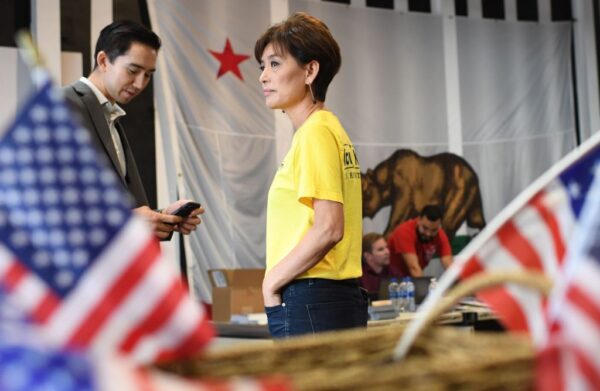
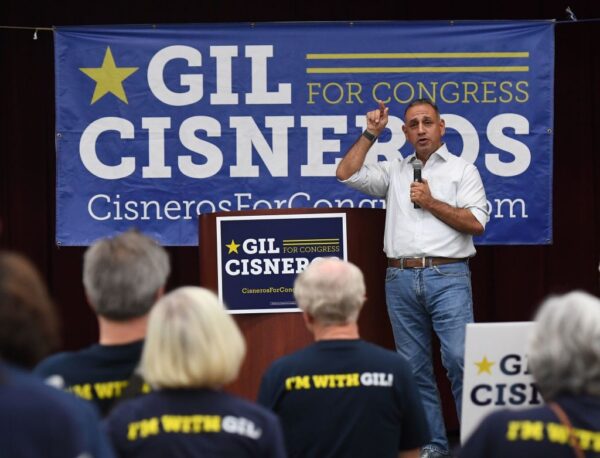
In District 45, “There are a number of Republican candidates trying to unseat Katie Porter, but the fractured field has left things scrambled,” Pyers said. “There is no clear Republican frontrunner, and the candidates are burning through whatever cash they’re raising to try to make it out of the primary. Meanwhile, Porter has been a consistently strong fundraiser and has over $3 million on hand.”
The District 48, Pyers said, “is becoming bluer, but it still has a strong conservative lean, and Democrats were able to capitalize on running against Dana Rohrabacher in 2018. This time around, the GOP has lined up behind Orange County Supervisor Michelle Park Steel. She’s well-funded and looks poised to give [Harley] Rouda a serious challenge.”
In District 49, “Mike Levin has been raising money at a brisk clip. The Republican in the race has been able to self-fund to a certain extent, but I’m not expecting him to be able to mount a competitive effort,” Pyers said.
In District 74, “There are two Republicans running against Cottie Petrie Norris. The most formidable appears to be Newport Beach Mayor Diane Dixon,” Pyers said.
“While Republicans are trying to claw back these seats, Orange County Republican incumbents in AD55, AD68, AD72, AD73, and SD37 are all going to have targets on their backs, and it’s not impossible to think that Democrats could gain even more ground in the Legislature in 2020,” Pyers said.
Vacant Seats
Two other races to watch are the 25th and 50th congressional districts.
The District 25 seat was left vacant by Democrat Katie Hill, who resigned last November after reports of alleged sexual misconduct.
She was accused of sexual indiscretions with a congressional staffer and also admitted to a relationship with a campaign aide in what has been described in the news media as a “throuple” relationship. Later, nude photos of Hill were published by a political blog, RedState, and the Daily Mail, a British tabloid. Hill served in Congress for less than a year, from Jan. 3–Nov. 3, 2019.
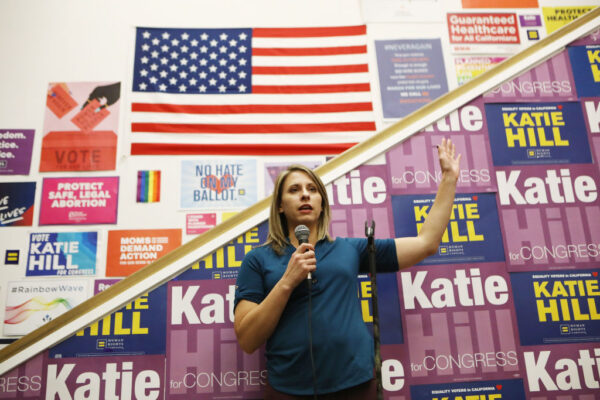
Primary candidates include Democrats Robert Cooper, Getro Elize, Christopher Smith, Christy Smith, Cenk Uygur, Anibal Valdez-Ortega; Republicans Mike Garcia, Kenneth Jenks, Stephen Knight, David Lozano, Daniel Mercuri, George Papadopoulos; and Independent Otis Lee Cooper.
Democratic contender Christy Smith is dominating the race so far, Jeffe and Quinn said.
California’s 25th congressional district is located in Southern California. It includes part of Los Angeles and Ventura counties.
In District 50, former U.S. Rep. Duncan Hunter resigned his congressional seat after he and his wife, Margaret, pleaded guilty to corruption for using campaign funds for personal expenses.
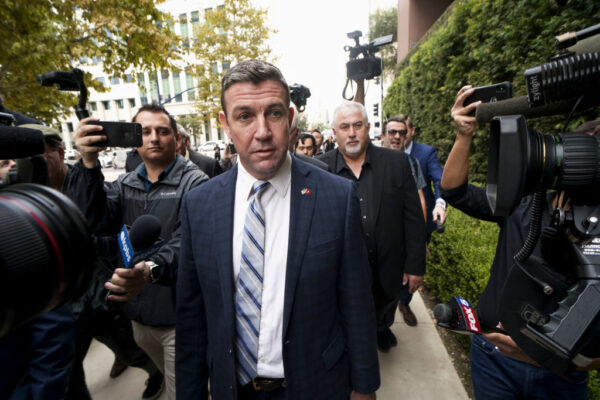
Federal prosecutors alleged that from 2009 to 2016, he spent campaign funds on extramarital affairs with five women, including lobbyists and congressional staff. Hunter resigned Jan. 13 after serving in Congress from 2009–2020.
Competing for the seat are Republicans, Darrell Issa, Brian Jones, Carl DeMaio, Nathan Wilkins; Democrats Ammar Campa-Najjar, Marisa Calderon; Independents Helen Horvath, Lucinda Jahn, Henry Ota; and Peace and Freedom Party of California candidate Jose Cortes.
Democrats have next to no chance of winning in the 50th District, Quinn said. It is the reddest district in the state, which Trump carried with a 58 percent majority in 2016.
“It’s between two guys trying to be the most Trumpy,” he said, referring to Issa and Jones.
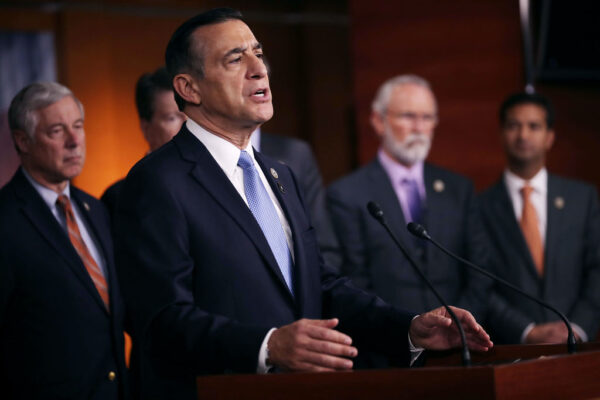
This district, numbered as California’s 52nd congressional district from 2009–2013, covers much of North San Diego County and part of Riverside County. It includes the cities of El Cajon, Escondido, San Marcos, Santee, and Temecula.
The Issues
“The main issue is there are no issues,” mainly because the primaries are being held three months earlier than usual, Quinn said.
Only about 20 percent of the early ballots have been returned by mail, he added. Neither of California’s two U.S. Senators—Diane Feinstein and Kamala Harris, both Democrats—are up for election and no statewide offices are up for grabs.
“So, all we have are congressional and legislative races. Basically, the only congressional races are Republicans trying to come up with candidates to take on the seven Democrats who were elected last time to Republican seats,” said Quinn. “Two years ago, I saw lots of yard signs for candidates. There seemed to be a lot of interest. That seems to be lacking right now. Nobody is really following it. The coverage has been very sparse.”
Homelessness and Housing Affordability
In California, the homelessness crisis will most likely be on the minds of voters, especially after California Gov. Gavin Newsom’s State of the State Address on Feb. 19 in which he focused heavily on homelessness, lack of affordable housing, substance abuse, and mental illness.
More than half of the electorate in Orange County believes homelessness is a significant problem, said Jeffe.
“It’s a very serious problem in the big cities driven by outrageously high housing costs,” Quinn said.
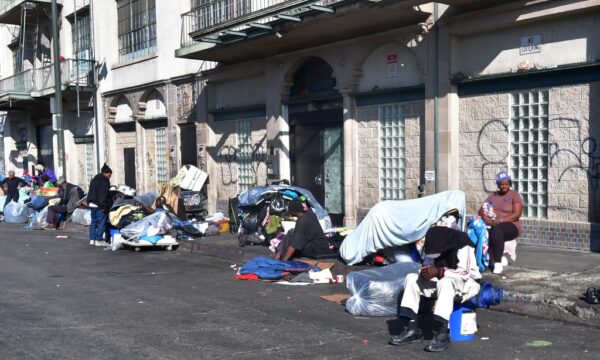
Sixty-three percent of Californians say housing affordability is a big problem in their part of the state, and another 25 percent say it’s somewhat of a problem, the PPIC survey found. About four in ten Californians (44 percent of adults and 38 percent of likely voters) say the cost of living is making them seriously consider moving elsewhere in California or out of state.
Younger Californians are more likely to consider moving—55 percent of those aged 18 to 34, 45 percent 35 to 54, and 33 percent of those 55 and older. Fifty-four percent of renters are far more likely than homeowners (32 percent) to consider moving. Most who are considering moving say they would leave California rather than relocate within the state.
The Economy
Both political analysts say California needs more blue-collar jobs, which along with more affordable housing, could help reduce the homeless population.
“The lack of jobs at the lower end of the economy is part of the problem,” Jeffe said. “You’re seeing more families, more people from the middle class who have been fired or laid off living in vans, living in cars … I don’t remember it ever being so visible.”
“We don’t have the good blue-collar jobs anymore that gave people a start in life, that allowed them to get a nice house at a reasonable price. That’s all disappeared in California,” Quinn said
Healthcare
With the electorate so focused on Trump and the presidential race, health care almost seems to have slipped off the radar, Jeffe said.
“It’s surprising it’s not healthcare,” she said. “Covered California appears to be working well.” Covered California allows people to purchase private healthcare at subsidized rates.
Although Quinn agrees that healthcare is not a major election issue in California, he said it should be.
“Obamacare has worked relatively well for California, which is why it’s just crazy to see all these Democrats trashing it,” Quinn said. “I mean, it took 10 years to get Covered California going. It’s an insurance plan. That’s all Obamacare ever was: an insurance plan subsidized by the state. But, it does seem to work, and it does seem to provide healthcare choice. The fact that Sanders and Warren want to throw the whole thing out, I think, is crazy.”
Although many middle-class Americans aren’t happy about the high costs of prescription drugs and soaring health insurance premiums, they’re not ready to dump their employer-based healthcare systems, he said.
Although many middle-class Americans aren’t happy about the high costs of prescription drugs and soaring health insurance premiums, they’re not ready to dump their employer-based healthcare systems, he said.
School Facilities Bond
Proposition 13, known as the School Facilities Bond, is the only ballot measure on the primary election ballot. A Yes vote, supported by Governor Gavin Newsom, would approve a $15 billion state bond program to finance construction and modernization updates for educational facilities.
There’s some confusion around it because it has the same designation as another Proposition 13, which capped increases on residential and commercial property taxes in 1978. “The original Prop. 13, I call the ‘real’ Prop. 13,” Jeffe said. Repealing the “real” one will be on the Nov. 3 ballot.
Meanwhile, last-minute legislation that Newsom signed into law on Feb. 13 could boost independent votes in the Democratic primary.
Senate Bill 207, authored by Sen. Melissa Hurtado (D-Sanger), allows voters to submit a signed written request to county election officials to change their political party preference or address within 14 days of an election until the close of polls on Election Day. The registration of the voter will be immediately updated and voters will receive a ballot or provisional ballot.
Drew Angerer/Getty Images
Bernie Sanders to Fund
‘Major’ Multitrillion-
Dollar Plans with
Military Cuts, Taxes, Lawsuits
25 Feb 2020204
6:12
Sen. Bernie Sanders (I-VT) on
Monday released a fact sheet explaining how he
will fund his “major” multitrillion-dollar campaign proposals — the Green New
Deal, free college, housing for all, etc. — and revealed that he will pay for
them through a combination of cutting military spending, creating new taxes,
and enacting penalties on the fossil fuel industry in the form of lawsuits.
While Sanders has released a suite of lofty plans with the
promise to improve the lives of middle class and low income Americans, critics
have repeatedly asked the socialist senator to explain how his administration
will pay for his grandiose proposals.
His campaign released a fact sheet on Monday listing each of his
“major plans” and providing a line on how he will make it a reality.
His $16.3 trillion Green New Deal plan, perhaps one of his most
prolific proposals, will be paid for, he claims, through a variety of methods
including slashes in military spending and lawsuits against the fossil fuel
industry.
He is calling to reduce defense spending by $1.215 trillion
“by scaling back military operations on protecting the global oil supply.” His
campaign claims he will raise $3.085 trillion by “making the fossil
fuel industry pay for their pollution, through litigation, fees, and taxes, and
eliminating federal fossil fuel subsidies.” He expects to garner
another $6.4 trillion “from the wholesale of energy produced by the
regional Power Marketing Administrations.”
“This revenue will be collected from 2023-2035, and after 2035
electricity will be virtually free, aside from operations and maintenance
costs,” his website states.
Sanders also claims his Green New Deal plan will create 20
million jobs, which will effectively create a new tax base and eliminate the
need for $1.31 trillion in “federal and state safety net spending due
to the creation of millions of good-paying, unionized jobs.”
His campaign actually argues that enacting his
multitrillion-dollar climate change proposal will save the United States $2.9
trillion in the next decade, $21 trillion over the next 30 years, and
$70.4 trillion over the next 80 years.
“If we do not act, the U.S. will lose $34.5 trillion by the
end of the century in economic productivity,” he claims.
That is far from Sanders’ only proposal. Offering free
college and cancelation of student debt will cost, according to his
estimates, $2.2 trillion. Sanders claims the plan is “fully paid” for with a
“modest tax on Wall Street speculation,” contending that it will raise more
than enough — $2.4 million over the next decade.
Sanders says his $1.5 trillion housing for all plan and $1.5
trillion universal child care/pre-K plan will be paid for with “a wealth tax on
the top one-tenth of one percent – those who have a net worth of at least $32
million.” He claims it will raise “a total of $4.35 trillion.”
His other plans rely almost entirely on new taxes on the
wealthy. His vow to erase $81 billion past-due medical debt will be “fully
paid for by establishing an income inequality tax on large corporations that
pay CEOs at least 50 times more than average workers.” Additionally, Social
Security expansion will be paid for, he says, with a tax on Americans with
incomes over $250,000.
Instead of
explicitly stating how Sanders will fund his Medicare for All plan, which some
experts say could cost over $60 trillion over
the next decade, the fact sheet simply touts a “menu of financing options that
would more than pay for the Medicare for All legislation he has introduced,”
which includes raising taxes on the middle class.
Per the fact sheet, those options include:
·
Creating a 4 percent income-based premium paid by employees,
exempting the first $29,000 in income for a family of four.
·
Imposing a 7.5 percent income-based premium paid by employers,
exempting the first $1 million in payroll to protect small businesses.
·
Eliminating health tax expenditures, which would no longer be
needed under Medicare for All.
·
Raising the top marginal income tax rate to 52% on income over
$10 million.
·
Replacing the cap on the state and local tax deduction with an
overall dollar cap of $50,000 for a married couple on all itemized deductions.
·
Taxing capital gains at the same rates as income from wages and
cracking down on gaming through derivatives, like-kind exchanges, and the zero
tax rate on capital gains passed on through bequests.
·
Enacting the For the
99.8% Act,
which returns the estate tax exemption to the 2009 level of $3.5 million,
closes egregious loopholes, and increases rates progressively including by
adding a top tax rate of 77% on estate values in excess of $1 billion.
·
Enacting corporate tax reform including restoring the top
federal corporate income tax rate to 35 percent.
·
Using $350 billion of the amount raised from the tax on extreme
wealth to help finance Medicare for All.
The release of the fact sheet follows Sanders growing
frustration over the mounting questions over the costs of his massive proposals.
Anderson
Cooper grilled Sanders on the costs of his various proposals during the
presidential hopeful’s recent sit-down interview with 60 Minutes.
“But you say
you don’t know what the total price is, but you know how it’s going to be paid
for. How do you know it’s going to be paid for if you don’t know how much the
price is?” Cooper asked.
“I can’t rattle off to you every nickel and every dime,” Sanders
said. “But we have accounted for — you talked about Medicare for All — we have
options out there that will pay for it.”
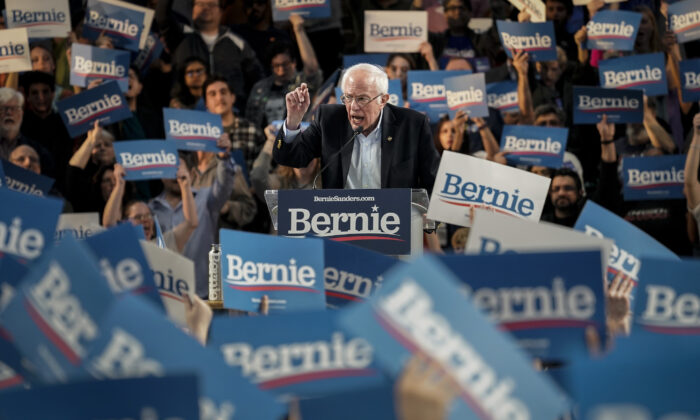
No comments:
Post a Comment